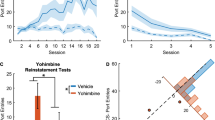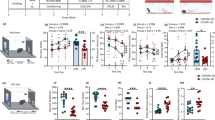Abstract
Rationale
Stressful events can have lasting and impactful effects on behavior, especially in terms of appropriate fear regulation and reward seeking. Our prior work in rats has shown baseline sex differences in fear expression and sucrose seeking in a discriminative reward-fear-safety conditioning task.
Objectives
The objectives of the current study were to determine how prior stress may affect alcohol consumption across a reward-fear-safety learning task, and how prior alcohol history may interact with stress to impact learning in this task.
Methods
Male and female Long Evans rats were given home cage intermittent 24 h access to both water and alcohol for 5 weeks. A subset of rats then received exposure to stress (15 unsignaled footshocks), while remaining unstressed rats received context exposure without shock. One week later, all rats were trained on the same reward-fear-safety cue task while having continuous home cage access to both water and alcohol.
Results
All rats increased consumption (g/kg/24 h) across the 5 weeks of intermittent access, with females showing higher consumption levels. Stress exposure did not alter alcohol consumption in the week following stress, but did increase home cage alcohol consumption during later reward-fear-safety cue learning. Stress in both sexes also elevated freezing levels to the reward cue resulting in decreased sucrose seeking and was positively correlated with home cage alcohol consumption.
Conclusions
While stress increased drinking in both males and females, the effects of stress were particularly pronounced in females, indicating our results could be capturing a higher propensity for females to display stress-induced drinking.








Similar content being viewed by others
References
American Psychiatric Association (2000) Diagnostic and statistical manual of mental disorders-text revision (DSM-IV-TR). American Psychiatric Press, Washington, DC
Blanchard RJ, Blanchard DC (1969) Crouching as an index of fear. J Comp Physiol Psychol 67:370–375
Broadwater M, Spear LP (2013) Consequences of ethanol exposure on cued and contextual fear conditioning and extinction differ depending on timing of exposure during adolescence or adulthood. Behav Brain Res 256(1):10–13
Fendt M, Fanselow MS (1999) The neuroanatomical and neurochemical basis of conditioned fear. Neurosci Biobehav Rev 23:743–760
Greiner EM, Müller I, Norris MR, Ng KH, Sangha S (2019) Sex differences in fear regulation and reward-seeking behaviors in a fear-safety-reward discrimination task. Behav Brain Res 368:111903
Kessler RC, Petukhova M, Sampson NA, Zaslavsky AM, Wittchen H (2012) Twelve-month and lifetime prevalence and lifetime morbid risk of anxiety and mood disorders in the United States. Int J Methods Psychiatr Res 21(3):169–184
Kirson D, Steinman MQ, Wolfe SA, Spierling Bagsic SR, Bajo M, Sureshchandra S, Oleata CS, Messaoudi I, Zorrilla EP, Roberto M (2021) Sex and context differences in the effects of trauma on comorbid alcohol use and post-traumatic stress phenotypes in actively drinking rats. J Neurosci Res 99(12):3354–3372
Meyer EM, Long V, Fanselow MS, Spigelman I (2013) Stress increases voluntary alcohol intake, but does not alter established drinking habits in a rat model of posttraumatic stress disorder. Alcohol Clin Exp Res 37:566–574
Müller I, Brinkman AL, Sowinski EM, Sangha S (2018) Adolescent conditioning affects rate of adult fear, safety and reward learning during discriminative conditioning. Sci Rep 8:17315
Ng K, Pollock MW, Urbanczyk PJ, Sangha S (2018) Altering D1 receptor activity in the basolateral amygdala impairs fear suppression during a safety cue. Neurobiol Learn Mem 147:26
Nutt DJ (2000) The psychobiology of posttraumatic stress disorder. J Clin Psychiatry 61(Suppl 5):24–32
Peltier MR, Verplaetse TL, Mineur YS, Petrakis IL, Cosgrove KP, Picciotto MR, McKee SA (2019) Sex differences in stress-related alcohol use. Neurobiology of Stress 10:100149
Pietrzaka RH, Goldstein RB, Southwick SM, Grant BF (2011) Prevalence and axis I comorbidity of full and partial posttraumatic stress disorder in the United States: results from Wave 2 of the National Epidemiologic Survey on Alcohol and Related Conditions. J Anxiety Disord 25:456–465
Sangha S, Chadick JZ, Janak PH (2013) Safety encoding in the basal amygdala. J Neurosci 33:3744–3751
Sangha S, Greba Q, Robinson PD, Ballendine SA, Howland JG (2014) Heightened fear in response to a safety cue and extinguished fear cue in a rat model of maternal immune activation. Front Behav Neurosci 8:168
Sangha S, Robinson PD, Davies DA, Greba Q, Howland JG (2014) Alterations in reward, fear and safety cue discrimination after inactivation of the prelimbic and infralimbic cortices. Neuropsychopharm 39:2405–2413
Segal D, Valyear MB, Chaudhri N (2022) The role of context on responding to an alcohol-predictive cue in female and male rats. Alcohol 99:70–81
van der Kolk BA (1997) The psychobiology of posttraumatic stress disorder. J Clin Psychiatry 58(Suppl 9):16–24
Venniro M, Banks ML, Epstein HM, DH, & Shaham Y, (2020) Improving translation of animal models of addiction and relapse by reverse translation. Nat Rev Neurosci 21(11):625–643
Woon E, Seibert T, Urbanczyk P, Ng KH, Sangha S (2020) Differential effects of prior stress on conditioned inhibition of fear and fear extinction. Behav Brain Res 381:112414
Mineur YS, Garcia-Rivas V, Thomas MA, Soares AR, McKee SA, Picciotto MR. Sex differences in stress-induced alcohol intake: a review of preclinical studies focused on amygdala and inflammatory pathways. Psychopharmacology (Berl). 2022 Mar 31. doi: https://doi.org/10.1007/s00213-022-06120-w. Epub ahead of print.
Acknowledgements
This work was supported by NIMHR01MH110425 to SS. We thank Yolanda Jonker and Signe Hobaugh for excellent animal care, and to Dr. Christopher Lapish for discussions regarding alcohol paradigms.
Author information
Authors and Affiliations
Corresponding author
Ethics declarations
Conflict of interest
The authors declare no competing interests.
Additional information
Publisher's note
Springer Nature remains neutral with regard to jurisdictional claims in published maps and institutional affiliations.
This article belongs to a Special Issue on Conditioned Determinants of Reward Seeking
Supplementary Information
Below is the link to the electronic supplementary material.
Rights and permissions
Springer Nature or its licensor holds exclusive rights to this article under a publishing agreement with the author(s) or other rightsholder(s); author self-archiving of the accepted manuscript version of this article is solely governed by the terms of such publishing agreement and applicable law.
About this article
Cite this article
Hackleman, A., Ibrahim, M., Shim, K. et al. Interaction of stress and alcohol on discriminating fear from safety and reward in male and female rats. Psychopharmacology 240, 609–621 (2023). https://doi.org/10.1007/s00213-022-06206-5
Received:
Accepted:
Published:
Issue Date:
DOI: https://doi.org/10.1007/s00213-022-06206-5




